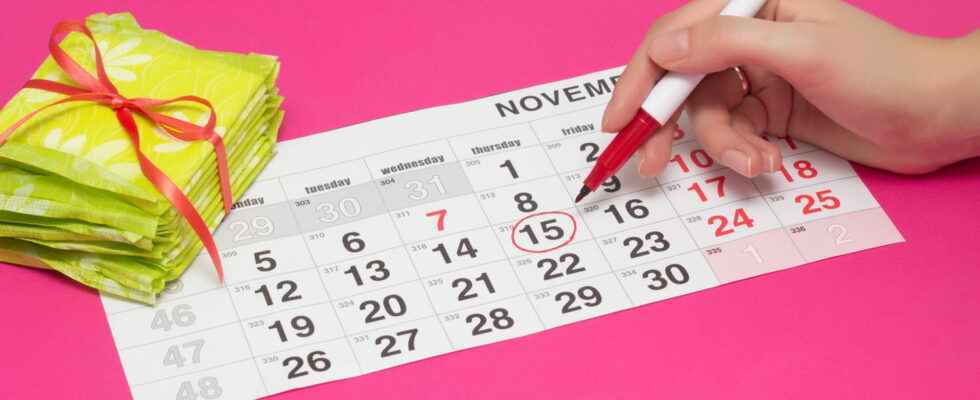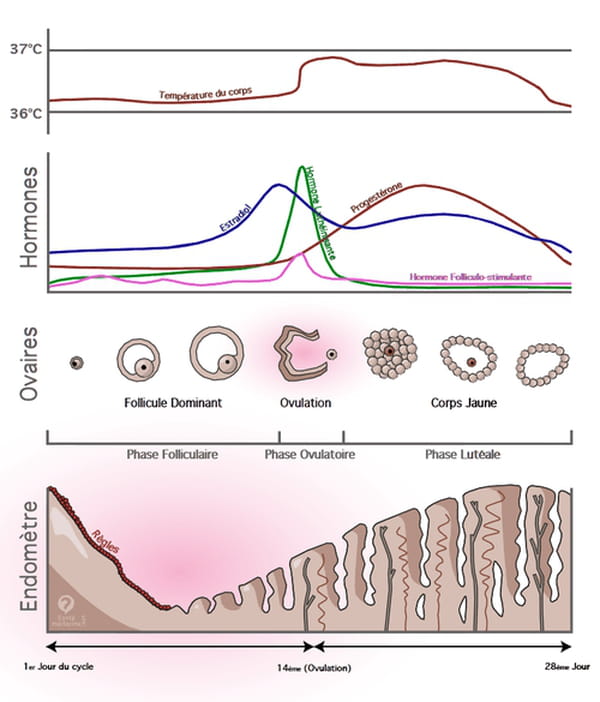Ovulation is the date when a woman ovulates. It lasts about 4 to 5 days. Calculating your ovulation date allows you to know the most fertile period of the menstrual cycle. But this can vary depending on whether you have a short, normal, long, irregular cycle…
L’ovulation corresponds to the date when the woman ovulates (the ovum is expelled by the ovary). It lasts approx. 4 to 5 days. Calculating your ovulation date allows you to know the most fertile period of the menstrual cycle. But this can vary depending on whether we have a cycle short, normal, long, irregular. Practical especially if you want to conceive a baby. How to calculate it reliably? What are the signs and symptoms of ovulation? When does fertilization take place after ovulation? What is the best fertilization period for a normal cycle? Irregular? Short or long? Is it possible to get pregnant right after your period? Answers in our comprehensive guide.
What is a female menstrual cycle?
To understand what ovulation is, you must first know what a female menstrual cycle is. the female cycle begins the first day of menstruation and ends on the first day of the next period. Thus, if the first day of the period is the 3rd of the month and the 1st day of the following period is the 31st of the month, the cycle will last 28 days. The menstrual cycle is made up of 3 phase :
- the follicular phase (about 14 days, including 5 days of menstruation),
- ovulation (24 hours on average)
- the luteal phase (about 14 days).
What is ovulation?
Ovulation corresponds to the phase of expulsion of the oocyte (egg) by the ovaryTherefore ready to be fertilized by a sperm and give birth to a embryo. Ovulation is a continuous physiological process beginning at puberty and ending at menopause. At menopause, the activity of the ovaries ceases and the woman has no more ovulation or periods. To know that as long as the menopause is not completely installed, it always ovulates and a pregnancy remains always possible. The lifespan of the egg is approximately 12 hours to 24 hours after its expulsion from the ovary. The sperm survive in the cervix and remain fertilizing for a period of approximately 3 to 5 days.
What is the post-ovulatory phase?
The post-ovulatory phase lasts in theory 14 days for a regular cycle of 28 days, but its duration can range from 10 to 20 days in the case of very irregular cycles.
What is fertilization?
The fertile period takes place around the date of ovulation, because this is the time when the egg is expelled and can meet the sperm, this period is also called the ovulation period. Fertilization refers to a fundamental stage of sexual reproduction, during which the male gamete fuses with the female gamete to form the egg, called the zygote. In humans, it is the sperm that plays the role of the male gamete and the egg that is the female gamete. The sperm contained in the semen emitted into the vaginal cavity of the woman will come into contact with the ovum, and one of them will penetrate into the ovum. After penetration, the oocyte will become “hermetic” to the entry of other spermatozoa, which allows the single egg development. Fertilization therefore corresponds to the phase of fusion between an ovum and a spermatozoon, which results in a single cell that is brought to become the embryo. In the absence of fertilization, there is a sudden drop in hormone levels and the onset of menstruation. In case of fertilization occurs a production of a specific hormone of pregnancy:HCG. This hormone makes it possible to maintain the production of other hormones and therefore to keep the endometrium intact so that the future embryo can “settle” there. The best time to conceive a babycalled fertile periodspreads out between the day before and just after the ovulation phase, that is approximately between the fourth day before ovulation and ends 24 hours after. Four days before and one day after the fourteenth day of the cycle are favorable days for fertilization for a 28-day cycle, either for a normal cycle, between the tenth day and the fifteenth day of the cycle. When this fertilization cannot be natural, we can practice in vitro fertilization which consists of the formation of an egg outside the woman’s body, then transferred to her uterus.
What are the symptoms of the ovulation period?
The period of ovulation can manifest itself through a whole procession of more or less marked symptoms, such as:
- feeling of breast tension,
- abdominal pain occurring on the side of the ovary which releases its oocyte,
- presence for 2 or 3 days of cervical mucus (mucus that protects the vagina from infections) and transparent and slightly sticky vaginal secretions whose consistency resembles that of egg white,
- feeling of increased libido.
The absence of these symptoms does not necessarily mean the absence of ovulation.
A normal cycle lasts 28 days. Ovulation takes place on the 14th day. This date of ovulation will make it possible to know the period of fertility. Ovulation, which lasts 24 hours, corresponds to the release of the oocyte from the ovary. The 14th day of the menstrual cycle, on a regular cycle of 28 days, remains the most fertile period. The first day of the cycle is the first day of menstruation. Attention: it is not because the ovulation of a regular cycle (28 days) occurs halfway through it that it always takes place halfway through the cycle (for example on the 16th day of a cycle of 32 days, or on the 12th day of a 24-day cycle). The expulsion of the egg usually takes place 14 days before menstruation begins. So, if you have irregular cycles and you can’t predict when your next period will be, it will be more difficult for you to determine your ovulation date. The use of a temperature chart or ovulation tests may be possible.
How to calculate your ovulation date when you have a normal cycle?
The best period is before and just after the ovulation phase, approximately between the 4th day before ovulation and ends 24 hours after. 4 days before and 1 day after the fourteenth day of the ovulation cycle, are favorable days for fertilization for a cycle lasting 28 days, i.e. in the case of a normal cycle, between the 10th day and the 15th day of the cycle. If the length of the menstrual cycle is more than 35 days, if it is less than 21 days, or if the menstrual cycle tends to be irregular, the results of this calculation may not be quite the same.
How to calculate your ovulation date when you have a short cycle?
The length of the cycle varies according to the women. If your cycle is shorter (less than 26 days), the follicular phase is shorter and therefore ovulation is earlier. If you have a cycle lasting, for example, 21 days: ovulation takes place on the 7th day from the first day of your period. The calculation is made by subtracting 14 days, duration of the luteal phase which does not vary, from the number of days of the cycle: i.e. 21 – 14 = 7. If the cycle has a duration of 22 days: ovulation will take place on 8th day, i.e. 22 – 14 = 8.
How to calculate your ovulation date when you have a long cycle?
If the cycle is longer than 33 days, the follicular phase is longer and ovulation occurs later (late ovulation) either the 19th day from the first day of menstruation: i.e. 33 days – 14 days = 19 days. If the cycle lasts 34 days: ovulation takes place on the 20th day, i.e. 34 – 14 = 20.
The previous calculations are quite theoretical. Thus, the fact of making a temperature curve makes it possible to determine very precisely the most favorable moment in order to optimize your chances of becoming pregnant. The diagram below shows how you should proceed to make a temperature curve to know precisely your ovulation.
What are ovulation disorders?
What is a late ovulation?
We call “late ovulation” when the egg is released much later, generally from the 21st day. What are the signs of late ovulation? The causes ? The results ? Can you get pregnant?
When to take an ovulation test?
To improve your chances of getting pregnant, you can take an ovulation test. This will allow you to know the most fertile period. When to do it? What is its principle?
In case of ovulation disorders or difficulties in conceiving, it is possible to resort to treatments to increase the chances of getting pregnant. Which treatments to choose? How long to take them? What are the contraindications?
TO REMEMBER :
- The date of ovulation corresponds the day the woman ovulatesin other words, when the egg is expelled by the ovary and the latter can be fertilized
- Determining your ovulation date allows you to know and target the most fertile period to maximize your chances of conceiving a child.
- When the cycle is regularthe ovulation date occurs on approximately the same day each cycle
- When the cycle is irregularthe date of ovulation varies.
- For a woman with a short cycle (22 days for example), the ovulation date is usually the 8th day of the cycle.
- For a woman with a normal cycle (28 days), the ovulation date is usually the 14th day of the cycle.
- For a woman with a long cycle (32 days), the ovulation date is usually the 18th day of the cycle.


